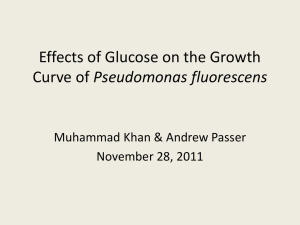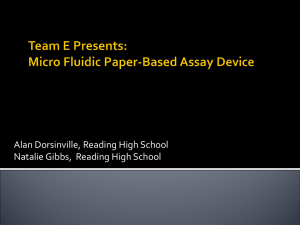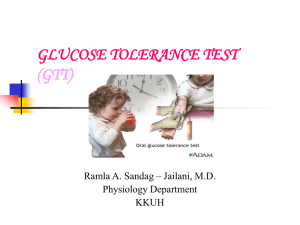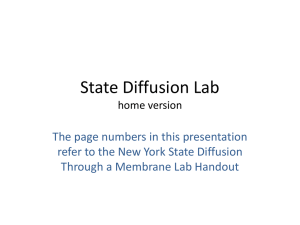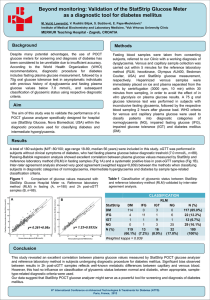Standardization of direct reading biosensors for blood glucose
advertisement
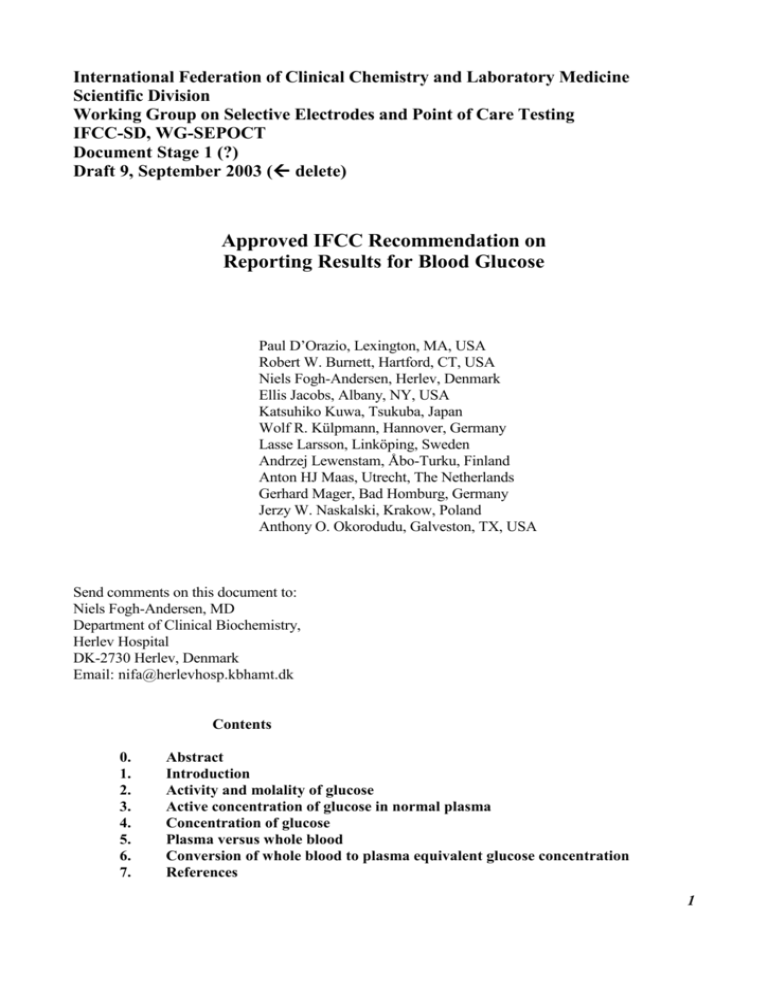
International Federation of Clinical Chemistry and Laboratory Medicine Scientific Division Working Group on Selective Electrodes and Point of Care Testing IFCC-SD, WG-SEPOCT Document Stage 1 (?) Draft 9, September 2003 ( delete) Approved IFCC Recommendation on Reporting Results for Blood Glucose Paul D’Orazio, Lexington, MA, USA Robert W. Burnett, Hartford, CT, USA Niels Fogh-Andersen, Herlev, Denmark Ellis Jacobs, Albany, NY, USA Katsuhiko Kuwa, Tsukuba, Japan Wolf R. Külpmann, Hannover, Germany Lasse Larsson, Linköping, Sweden Andrzej Lewenstam, Åbo-Turku, Finland Anton HJ Maas, Utrecht, The Netherlands Gerhard Mager, Bad Homburg, Germany Jerzy W. Naskalski, Krakow, Poland Anthony O. Okorodudu, Galveston, TX, USA Send comments on this document to: Niels Fogh-Andersen, MD Department of Clinical Biochemistry, Herlev Hospital DK-2730 Herlev, Denmark Email: nifa@herlevhosp.kbhamt.dk Contents 0. 1. 2. 3. 4. 5. 6. 7. Abstract Introduction Activity and molality of glucose Active concentration of glucose in normal plasma Concentration of glucose Plasma versus whole blood Conversion of whole blood to plasma equivalent glucose concentration References 1 Abstract In humans, glucose is distributed like water between erythrocytes and plasma. The molality of glucose (amount of glucose per unit water mass) is the same throughout the sample. Different water concentrations in calibrator, plasma, and erythrocyte fluid can explain some differences of glucose measurements. Results depend on sample type and on whether methods require sample dilution or use biosensors in undiluted samples. Different devices for the measurement of glucose may detect and report fundamentally different quantities. The differences exceed the maximum allowable error of glucose determinations for diagnosing and monitoring diabetes mellitus, and they complicate the treatment. The goal of the International Federation of Clinical Chemistry and Laboratory Medicine, Scientific Division, Working Group on Selective Electrodes and Point of Care Testing (IFCC-SD, WG-SEPOCT) is to reach a global consensus on reporting results. The document recommends reporting the concentration of glucose in plasma (with the unit mmol/L), irrespective of sample type or measurement technique. A constant factor of 1.11 is used to convert concentration in whole blood to the equivalent concentration in the pertinent plasma. Key words: Activity; Biosensors; Glucose oxidase; Hematocrit; Plasma vs Whole Blood; Standardization; Water concentration. 2 1. Introduction The World Health Organization (WHO) and the American Diabetes Association (ADA) define the diagnosis of diabetes mellitus by at least two measurements of fasting plasma glucose concentration > 7.0 mmol/L. As an alternative, a random venous plasma glucose concentration > 11.1 mmol/L in the presence of symptoms or a 2-h post oral glucose tolerance test result > 11.1 mmol/L suffice to make a definite diagnosis of diabetes mellitus (1, 2). The new classification of “impaired fasting glycemia” has a narrower interval of 6.1-6.9 mmol/L in venous plasma glucose concentration than the previous fasting interval of 5.6-7.7 mmol/L between normal and diabetic classifications (3). The narrower diagnostic limits increase the need for reliable results to classify individuals correctly. Currently, various types of instruments detect and report fundamentally different glucose quantities. Biosensors for glucose are “direct reading” when they measure glucose directly, i.e. without prior dilution of the sample. The new generation of direct reading glucose sensors responds to the molality of glucose, which is identical in whole blood and plasma, whereas the concentration of glucose in the two systems is different. Methods requiring high sample dilution will produce results equivalent to concentration when calibrated against aqueous standards, because the water concentrations of sample and calibrator are almost identical after dilution. The original intention of the IFCC-SD WGSE was to make a recommendation for direct reading biosensors in blood gas/electrolyte/metabolite analyzers. However, an isolated recommendation would be meaningless and not lead to the goal of harmonized results, which requires a consensus on reporting results for all analyzers. Inexpensive instruments with direct reading biosensors are available for self-monitoring or point of care testing of glucose (4-6). The clinical chemistry laboratory is expected to perform glucose determinations by direct reading sensors concurrently with other routine instruments that measure substance concentration in diluted samples. In current clinical practice, plasma and blood glucose are used interchangeably (7) with a consequent risk of misinterpretation. The two systems are frequently mistaken in the clinical literature, despite an average 11 % difference in glucose concentration (plasma>blood). The American Diabetes Association provides clinical decision limits for the concentration of glucose in venous plasma, but the World Health Organization in addition provides the concentration of glucose in whole blood (1-3). With the present use of multiple methods providing results of different quantities, there is a serious risk of clinical misinterpretation. We recommend a constant factor of 1.11 for the conversion between concentration of glucose in blood and the equivalent concentration in the pertinent plasma, and only reporting the concentration of glucose in plasma to avoid misjudgements. The converted result equals the concentration of glucose in plasma when hematocrit and water concentrations are normal. The recommendation includes point of care devices and methods that measure the concentration of glucose in whole blood. The conversion does not eliminate current pre-analytical influences or hematocrit effects, which are specific to certain methods and summarized in reference (4). However, the conversion will provide consistent harmonized results, facilitating the classification and care of patients and leading to fewer therapeutic misjudgments. The concentration of glucose depends on sampling site, especially when the patient is not fasting. Therefore, the sampling site must be specified, and information about sampling site must accompany the result. For testing of glucose tolerance, venous samples are preferred. The conversion factor is only valid for samples from the same sampling site (e.g. venous blood). It does not apply to calculation of venous plasma glucose concentration from concentration of glucose in arterial or capillary blood. 3 2. Activity and molality of glucose Biosensors respond to activity of the pertinent analyte. The activity of glucose is assumed equal to molality, with a molal activity coefficient equal to one. Activity (a, dimensionless) is related to the chemical potential (µ = µ0 + RTlna of unit kJ/mol). Molality (m, of unit mmol/kg H2O) is amount per unit water mass. The relation between m and concentration, c (of unit mmol/L) is m = c/H2O. H2O is the mass concentration of water (of unit kg/L). Calibration of direct reading glucose biosensors with aqueous glucose calibrators without considering water concentration provides results of ‘relative molality’ that are numerically higher than the concentration, but slightly lower than true molality. Multiplying the results by the ratio of water concentrations in sample and calibrator converts ‘relative molality’ to concentration. Mass concentration of water (kg/L) in average “normal” erythrocyte cytoplasm is 0.71, whole blood/hemolyzed blood 0.84, plasma 0.93, and aqueous calibrator 0.99. “Normal” here is defined as hematocrit 0.43, and concentration of protein and lipid in plasma within the reference interval. Effect of variation within the reference interval is negligible. Activity is physiologically relevant for determining enzymatic reaction rate, direction of chemical processes, transport, and binding to receptors. Glucose permeates the erythrocyte membrane quickly, by passive transport (facilitated by the erythrocyte glucose transporter, which catalyzes the uniport movement of D-glucose down its concentration gradient). Therefore, the molality of glucose is identical in erythrocytes and plasma. Results obtained by a direct reading glucose biosensor responding to molality are identical for whole blood and its separated plasma. A new quantity and reference interval for glucose based on molality would add to the present risk of clinical misinterpretation, add to the confusion regarding sample type and analytical methodology and would not be acceptable in clinical practice. Direct reading glucose biosensors that detect molality of glucose are available on combined blood gas/electrolyte/metabolite analyzers from the major manufacturers of these systems. Several point of care devices also use direct reading glucose biosensors. Some blood gas/electrolyte/metabolite instruments with direct reading glucose biosensors are calibrated with aqueous calibrators to provide results according to the ‘relative molality’ of glucose in the sample. The predicted ratio of results by such instruments to those that investigate diluted specimens is 1.18 (= 0.99/0.84) for normal whole blood, and 1.06 (= 0.99/0.93) for normal plasma, in agreement with results from the literature (8, 9). Unconverted results may be misleading if they are related to established reference intervals and clinical decision limits, and continued use of these instruments without conversion may cause confusion with conventionally determined glucose concentrations. 3. Active concentration of glucose in normal plasma The converted results based on measured glucose activity and average concentration of water in normal plasma are called active concentration of glucose in normal plasma to distinguish from substance concentration of glucose in actual plasma. We recommend converting and reporting results from all systems and devices using direct reading glucose biosensors as the active concentration of glucose in normal plasma (10) and using the unit mmol/L. This recommendation is in harmony with that of the ADA (2). Another reason for choosing plasma rather than whole blood as the system of reference is its independence from hematocrit. The advantage of direct reading glucose biosensors responding to activity and molality will not be lost. The converted results of direct reading glucose biosensors are proportional to the activity and molality of glucose (contrary to the less physiological substance concentration of glucose), due to the constant factor relationship. The ratio between active and conventional concentration of glucose in a given plasma sample equals the ratio of water concentration between average and actual plasma (with a mean of 1.00 and SD of 0.01, if the water concentration is normal). In practice, the two can be considered identical. Subgroups like neonates or pregnant women may have slightly higher-than-average plasma water concentrations. A lower-than4 average actual plasma water concentration due to e.g. hyperlipidemia will lead to lower conventionally used substance concentration, but has no impact on active concentration of glucose. The active concentration of glucose is unaffected by changes in water concentration, but the conventionally used concentration will change in proportion to the water concentration. For the same reason, control material with assigned glucose concentration must have a normal water concentration of 0.93 kg/L to be valid for quality assessment of direct reading glucose biosensors. Otherwise, the water concentration must be taken into account. 4. Concentration of glucose Most current photometric methods to measure glucose use enzymatic conversion with NADH or NADPH as coenzymes and absorbance measurements near or at 340 nm. The molar absorptivity permits direct calculation of the glucose concentration after complete reaction. The concentration can also be determined by a kinetic measurement, comparing sample to standard. A kinetic measurement obviates subtraction of background, at the cost of introducing a small positive bias. After 50 fold dilution, the mass concentration of solutes is ~ 4.0 g/L in case of whole blood, and less in case of plasma. Enzymatic reaction rate depends on substrate activity (or molality). The slightly lower water concentration in diluted sample as compared to diluted calibrator provides a relatively (slightly) higher enzymatic reaction rate in the diluted sample. Methods that include protein precipitation may also have a positive bias, depending on the degree of dilution and concentration of protein. The precipitation creates a non-homogeneous system. The aqueous phase has a higher concentration of glucose than the precipitated protein or the precipitant containing solution before centrifugation. Despite these (minor) theoretical queries, clinical chemical routine analyzers measure glucose concentration (amount of glucose per volume of sample) with sufficient trueness and precision. Biosensors that require dilution provide results that closely resemble concentration. These devices report concentration, based on the concentration of glucose in the calibrator. Dilution decreases the concentration of all components except that of solvent, which approaches the concentration of solvent in the diluent. After a dilution in e.g. 1:25 ratio, the water concentration of diluted sample and aqueous calibrator differs less than 1% at the time of measurement. The consequence is a small positive bias of less than 1% in the reported concentration, depending on the original concentration of solutes. 5. Plasma versus whole blood and serum On a concentration basis (amount of glucose per liter of sample), glucose concentration in plasma is higher than glucose concentration in erythrocytes because the water concentration is higher in plasma than in erythrocytes. Unlike direct reading glucose biosensors, methods that use diluted samples will produce results that depend on the water concentration of the sample. Therefore, methods requiring sample dilution will produce different results for blood (or hemolyzed blood) and corresponding plasma. Consider, e.g., a blood specimen with a hematocrit (Hct) of 0.43. The water concentration of erythrocytes is ~ 0.71 kg/L. The water concentration of plasma is ~ 0.93 kg/L. The water concentration (kg H2O/L) of the blood specimen must be intermediate to these extremes, (0.43)*(0.71)+(1-0.43)*(0.93) = 0.84. The ratio of water and, therefore, glucose concentration between plasma and whole blood is 0.93/0.84, or 1.11. The ratio depends on hematocrit. A decrease of Hct causes an increase of glucose concentration in whole blood and vice versa. When hematocrit is known to be abnormal, whole blood glucose concentration can be “hematocrit adjusted” to a normal hematocrit of 0.43 by multiplication with 0.84/(0.93-0.22*Hct). Unfortunately, some methods may have additional erythrocyte or hemoglobin interference. Plasma and whole blood glucose concentrations are not interchangeable due to the 5 difference in glucose concentration between plasma and whole blood (in contrast to current practice in many institutions). Different reference intervals and clinical decision limits apply. The recommendation here is to report only the concentration of glucose in plasma, irrespective of material investigated. Glucose and water distribute freely between erythrocytes and plasma, so the molality (but not the concentration) of glucose is identical in erythrocytes and plasma. Therefore, for given concentration of glucose in plasma, the concentration of glucose in whole blood depends on hematocrit, because erythrocytes have lower water concentration than plasma. The concentration of glucose in plasma is independent of hematocrit. Glucose activity and concentration are practically proportional in plasma, where the water concentration varies relatively little, but not in whole blood, where hematocrit may vary considerably and confound the relation. The concentration of glucose in plasma (rather than the concentration in whole blood) therefore more closely reflects the activity of glucose. For most purposes, the concentration of glucose in plasma is physiologically more relevant to measure and report than the concentration in whole blood. The use of serum is discouraged, as the concentration of glucose decreases during its preparation. Likewise, the concentration of glucose in capillary whole blood should not be used as substitute for the concentration in venous plasma (11). The type of specimen has not always received the attention it deserves. For instance, the ADA recommends a maximum allowable CV of 10 % at glucose concentrations of 1.7 to 22 mmol/L and a maximum bias of 15 % from a reference method value (12-13). In other words, the ADA accepts no more than 5 % analytical error for glucose determination (13). The systematic 11 % difference between normal blood and plasma already exceeds the recommended allowable maximum error. Mistaking or not properly distinguishing sample type may result in misinterpretation of the result and a wrong diagnosis. According to an editorial (14), reporting whole blood glucose values is anachronistic and comparable to reporting whole blood instead of plasma concentration of potassium. Manufacturers and clinical chemists always should report the concentration of glucose in plasma to avoid this risk, irrespective of sample type and method of measurement. Unmodified direct-reading biosensor result ”relative molality” of glucose in plasma or whole blood (not recommended ) 0.94 Concentration of glucose in plasma (recommended) 1.18 1.11 Concentration of glucose in whole blood (not recommended) Figure 1. Conversion factors for different quantities of glucose. 6. Conversion of whole blood to plasma equivalent glucose concentration The present IFCC document recommends using a constant factor of 1.11 for converting concentration of glucose, based on water concentrations of normal whole blood and of normal plasma. The relationship has been supported experimentally (8,9). Conversion based on measured hematocrit may introduce additional error (9), besides being less convenient and requiring additional information. 6 Converted (whole blood ---> plasma) glucose concentrations will have the same dependence on hematocrit as the presently reported whole blood glucose concentrations. With this convention, all results can be harmonized and reported as concentration of glucose in plasma. The laboratory, however, must keep information about which sample type and measurement procedures were used. 7. References 1. World Health Organization. Definition, diagnosis and classification of diabetes mellitus and its complications: report of a WHO consultation. Part 1: diagnosis and classification of diabetes mellitus. Geneva: World Health Organization; 1999. 2. Report of the expert committee on the diagnosis and classification of diabetes mellitus. Diabetes Care 1997; 20: 1183-97. 3. Diabetes mellitus. Report of a WHO Study Group, World Health Organization Expert Committee. Tech Report Ser 727. Geneva, Switzerland: WHO, 1985. 4. Chance JF, Li DJ, Jones KA, Dyer KL, Nichols JH. Technical evaluation of five glucose meters with data management capabilities. Am J Clin Pathol 1999; 111: 547-56. 5. Johnson RN, Baker JR. Accuracy of devices used for self-monitoring of blood glucose. Ann Clin Biochem 1998; 35: 68-74. 6. Kost GJ et al. Multicenter study of oxygen-insensitive handheld glucose point-of-care testing in critical care/hospital/ambulatory patients in the United States and Canada. Crit Care Med 1998; 26: 581-9. 7. Burrin JM, Alberti KGMM. What is blood glucose: can it be measured? Diabetic Med 1990; 7: 199-206 8. Fogh-Andersen N, Wimberley PD, Thode J, Siggaard-Andersen O. Direct reading glucose electrodes detect the molality of glucose in plasma and whole blood. Clin Chim Acta 1990; 189: 33-8. 9. Fogh-Andersen N, D'Orazio P. Proposal for standardizing direct-reading biosensors for blood glucose. Clin Chem 1998; 44: 655-9. 10. Siggaard-Andersen O, Durst RA, Maas AHJ. Physicochemical quantities and units in clinical chemistry with special emphasis on activities and activity coefficients. IUPAC/IFCC recommendation. J Clin Chem Clin Biochem 1987; 25: 369-91. Ann Biol Clin 1987 ; 45: 89-109. 11. Stahl M, Brandslund I, Jorgensen LG, Hyltoft Petersen P, Borch-Johnsen K, de Fine Olivarius N. Can capillary whole blood glucose and venous plasma glucose measurements be used interchangeably in diagnosis of diabetes mellitus? Scand J Clin Lab Invest 2002; 62:159-66. 12. American Diabetes Association. Consensus statement - self monitoring of blood glucose. Diabetes Care 1990; 13 (Suppl 1): 41-6. 13. American Diabetes Association. Self-monitoring of blood glucose. Diabetes Care 1994; 17: 81-6. 14. Rainey PM, Jatlow P. Monitoring blood glucose meters. Editorial. Am J Clin Pathol 1995; 103: 7 125-6. 8



